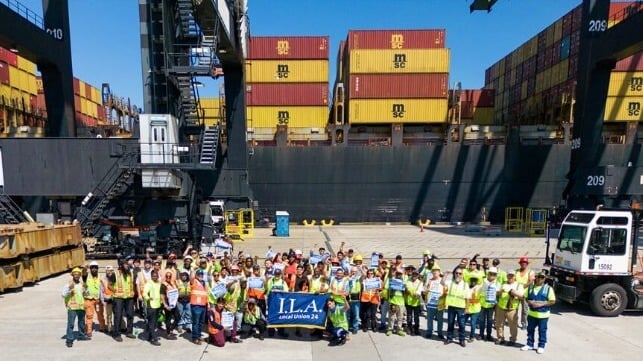With Two Weeks Left and No Talks, Industry Prepares for ILA Strike

Today marks two weeks till the likely first day of a crippling strike for containers and Ro-Ro traffic at U.S. East and Gulf Coast ports as the International Longshoremen’s Association has refused to resume negotiations on the master contract. With no signs of government intervention despite urging from shippers, the industry is looking for alternatives while analysts attempt to forecast the impact.
A wide collation of 177 trade associations ranging from manufacturers to farmers, wholesalers, retailers, manufacturers, and many others in the supply chain, issued an open letter to President Joe Biden expressing “significant concern about the state of the negotiations,” saying it is “imperative” for the administration to get the sides back to the negotiating table.
The ILA, however, issued a new statement focusing entirely on wages and rehashing old wage increases, or the lack thereof, dating back to the 1990s. Citing inflation and years of low increases, the ILA says “spotty yearly increases” are history. The ILA said it will reject the USMX (United States Maritime Alliance) position on new entry wage, and calls for large increases.
The union writes that it has been preparing for over a year and the time is now to take a “stand and fight a higher level of wages.” Without indicating any willingness to resume the negotiations which have been at an impasse since June, the ILA says a strike “seems more likely.”
Terminal operators represented by the USMX have repeatedly called for a resumption of negotiations. Their statements talk of “industry-leading” wage offers, which the ILA rejects as misleading.
“A strike at this point in time would have a devastating impact on the economy, especially as inflation is on the downward trend,” the collation of trade associations predicts in its letter.
The White House and administration have not indicated that it would be stepping in during the remaining two weeks. Reuters is quoting a source today saying the administration has decided not to invoke the Taft-Hartley Act which would permit it to invoke a cooling-off period to extend negotiations. Last year, however, the White House sent the Acting Secretary of Labor, Julie Su, to assist with the contract talks on the West Coast. She was credited as being instrumental in getting an agreement after a year of negotiations and growing labor actions disrupting the ports.
It will be the first coastwide strike on the East Coast since the 1970s, leaving analysts unsure what will happen. Some are predicting massive worldwide backlogs and repercussions if the strike drags on with the carriers also forecasting a likely wide impact on an industry already under pressure from disruptions.
CMA CGM wrote to customers yesterday saying it knows there will be increasing attention on the negotiations in the next two weeks. It says it is “ready, willing, and able to provide customers with solutions and alternate modalities to keep supply chains moving as best as possible.”
The Port of Long Beach reported yesterday that it had its busiest month ever in August with a 40 percent year-over-year increase in import volumes. They cited cargo diversions and concerns about the U.S. tariff increases on China while saying they were preparing for “the uptick in shipments and continued growth through the rest of the year.”
The ILA however has already cited how it picketed ships on the West Coast that were attempting to divert cargo during its last strike.
Canadian ports might be able to take some of the U.S. volume. Analysts have also predicted that it could be a significant boost to the air cargo sector.
Cargo industry analyst Container xChange told customers today, that for container trading and leasing companies, the disruptions could lead to significant delays and port congestion, impacting equipment turnaround times. They noted shippers are in a traditional peak season but many took steps to prepare.
“While the threat of strikes looms large, it’s important to note that U.S. inventories are currently strong due to the pulling forward of orders earlier this year to avoid existing disruptions. This stockpile will act as an essential buffer, mitigating the risk of container rates spiking dramatically due to the strikes,” said Christian Roeloffs, co-founder and CEO of Container xChange. He predicted, “the overall impact will largely depend on the duration of the strikes, with prolonged disruptions having the potential to intensify the implications for supply chains, leading to more pronounced bottlenecks and greater challenges in container availability.”
